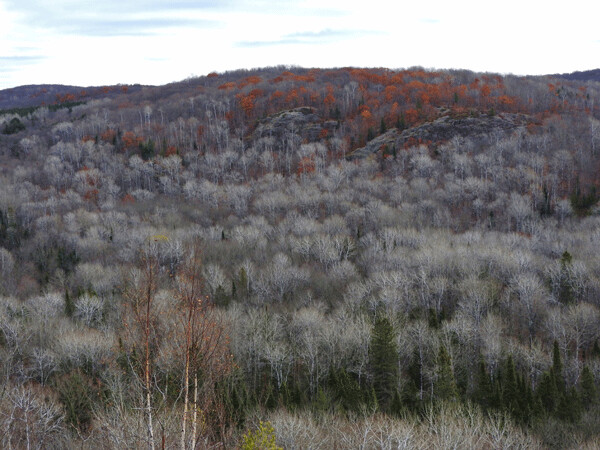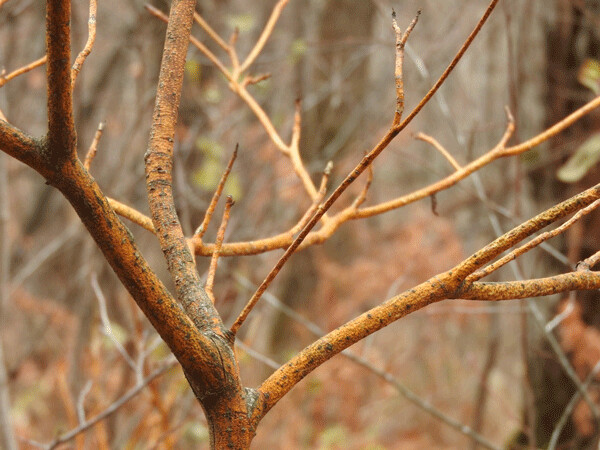News & Articles
Browse all content by date.

“November is a sigh; a sigh of weariness after the tumult of summer, a sigh of resignation over projects yet undone, a sigh of regret for hopes unfulfilled,” wrote Lois Nestel, the Museum’s founding director. Not much has changed in the intervening decades. As our vision is filled by low light, gray skies, and bare trees, keeping a cheerful attitude can feel like a challenge.
My solution? Go outside anyway. Nothing improves my mood like fresh air and exercise. Besides, hot chocolate and cookies taste so much better once they’ve been earned. So on a recent gray morning I set out on one of my favorite sections of the North Country Trail. The little 0.7 mile jaunt to Juniper Rock Overlook is one of the most popular sections of trail. In the middle of a region socked in by trees, stepping out onto the craggy nose of bedrock above the Marengo River valley invites a deep breath and soul expansion.
The overlook is especially popular in the midst of fall colors. The greens of summer mask the diversity of the forest until early October, when the red maples send up their flares, the sugar maples smolder orange, and the aspens glow yellow. With the recent gales of November, though, I expected I’d find a plain, gray view. What actually greeted me at the top was much nicer.
The deep greens of spruce and fir trees lining the Marengo River marked a sinuous path along the valley floor. Flanking them, the forest looked almost fluffy, with the pale, round crowns of aspen trees mimicking translucent cotton balls. Far across the valley, a rich brown shawl of oak leaves—still clinging to their twigs—warmed the shoulders of another craggy outcrop. In the foreground, a slender trio of paper birch saplings raised their purple twigs skyward. Finally, sunshine peeked out of a hole in the clouds. The vibrant colors of autumn leaves are not just for show. All summer, orange carotene pigments capture wavelengths of light that the green chlorophyll cannot, and then transfer that energy over to help fuel photosynthesis. Yellow xanthophyll pigments absorb dangerous excess energy in the leaf and dissipate it as heat. Both are revealed when the trees start to remove nutrients from the green chlorophyll and save them in the twigs for use next spring.
Likewise, the pale color of the aspen twigs facilitates photosynthesis, allowing the trees to make food in late fall and early spring, as long as the sun can warm their wood up to at least 45 degrees.


If you scratch the surface off the young twig of almost any northern tree, you’ll find a thin layer of green—chloroplasts that are ready to make sugar. In aspen trees, their pale, thin outer bark stays translucent for longer as they age, and allows them to photosynthesize throughout more of their surface area. As trees grow, their cells give off carbon dioxide, which can be taken up directly by their inner chlorophyll and used for photosynthesis. In turn, the oxygen produced as a byproduct of making sugars gets harnessed for respiration.
The pale bark of young birch trunks also lets some light in for photosynthesis, but the deep purple of birch twigs may be a sunscreen to prevent damage through the dormant season. The difference in twig color between aspens and birches is helpful when identifying them from afar.
My stop at Juniper Rock was brief, because the bedrock cliff with the oak shawl was beckoning. It, too, is accessible from the North Country Trail. As I climbed up the far side of the river valley, more color caught my eye among the pale trunks of aspen and gray spindles of ironwood. The purple and gold of gracefully upward-arching twigs were so rich that they reminded me of the team colors of our high school rivals.
I suppose they are rivals of some sort. Rich purple is the normal color of twigs on pagoda dogwood (also known as alternate-leaved dogwood). The golden twigs are dead or dying, having been invaded by a fungus called golden canker. The fungus may live among the cells of healthy-looking dogwoods for years before the symptoms of yellowing bark and tiny orange polka dots manifest. I rarely see a pagoda dogwood shrub without at least one golden twig, and these contrasting colors were pointed out in my very first botany class as a clue to identification.
By the time I finally reached that far, oak-shrouded overlook and gazed back across the valley at Juniper Rock, more patches of blue sky had materialized. My mood had lifted, too, buoyed by both my ability and willingness to appreciate color where it can still be found. Lois Nestel must have been on a similar journey when she wrote that essay many decades ago, because by the end of it, she offered these words of wisdom: “A proper perspective is what we need, and perhaps a closer bond with nature could teach us. That lesson learned, how good it would be if our sighs of dissatisfaction could become sighs of contentment and peace.”
Now, who’s up for some hot chocolate and cookies?
Find directions to the trailhead at: https://www.cablemuseum.org/get-outside/ Emily’s second book, Natural Connections: Dreaming of an Elfin Skimmer, is now available to purchase at www.cablemuseum.org/books and at your local independent bookstore, too.
For more than 50 years, the Cable Natural History Museum has served to connect you to the Northwoods. Come visit us in Cable, WI! Our new Curiosity Center kids’ exhibit and Pollinator Power annual exhibit are now open! Call us at 715-798-3890 or email emily@cablemuseum.org.
| Tweet |


